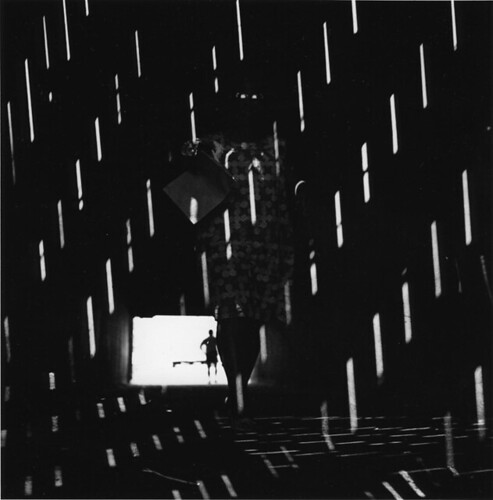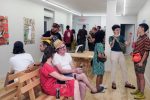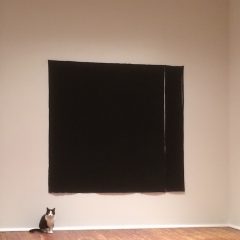Museums are not the only permanent collections of art in town. I was reminded of this while I was talking to Karen Lightner, who heads the Print and Pictures Collection at the Free Library.
I stopped in to talk with her while I was looking at the Continuum: Photography in Philadelphia, which Lightner curated. The exhibit is an annual show mounted each year to coordinate with the Robert F. Looney Memorial Event. Looney was curator of prints and photographs at the library from 1963 to 1986, and his wise choices are part of the reason he’s held in such esteem.
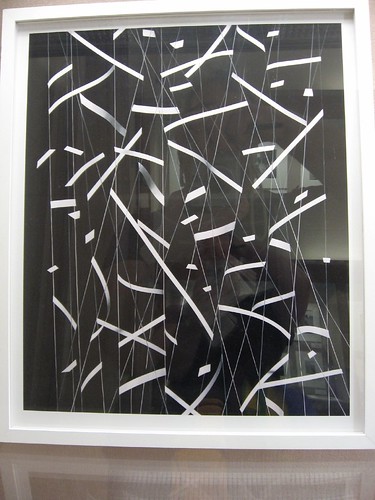
Brent Wahl, Untitled (tape and wire), 2006, chromogenic print
Continuum, this year’s exhibit, features photographs of established and upcoming talents. Lightner, who I have known since 1982 or so, when she used to live next door to me, invited five local photographers to participate, each representing a different local art program. She asked them each to select a former student to also be included in the exhibit.
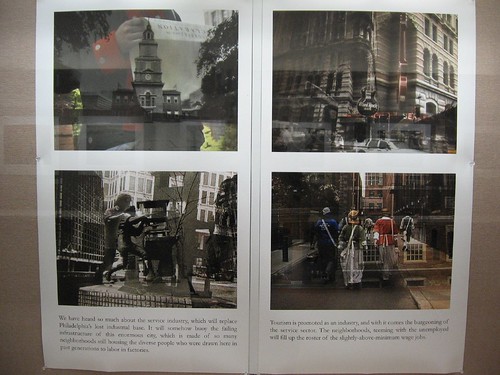
Karen Lefkovitz, Stills and text from video, Tales of Tourism, 2007. These images have traveled through a number of technological transitions, thus representing their own history as well as the history they are recording. It has a book-like quality, with multiple images and text.
Here’s the who’s who: Paul Runyon, faculty at Drexel asked former student Mike Froio; Karen Lefkovitz at Moore asked Cori Crowley; Martha Madigan at Tyler asked Jim Robinson; Alida Fish from UArts asked Manuel Dominguez Jr.; and Gabriel Martinez, from Penn, asked Brent Wahl.
The exhibit also includes selections of local photographs that had been purchased by Looney. So Continuum is three generations of Philadelphia photography, with some outstanding items in all three groups. I’ll throw up some pictures from the exhibit to decorate my interview with Lightner, who is still buying and soliciting items for the collection, which thanks to her now includes about 100 artists books, five Zoe Strauss photographs as well as the two portfolios that make up Daniel Heyman’s Abu Ghraib prints. “I got the Art Department to give me enough money to give me one set, and he’s giving us the other set,” Lightner said.
That’s typical of how Lightner operates on a shoestring budget. Here’s our conversation:
L. How do you make choices of what to buy for the collection?
K. I get to buy what’s within the scope of what the collection already has. We have print-making, fine art photography, Philadelphiana images and an artists book collection. One of the things I have done, is we had a really tiny artists book collection, maybe 20. I was an artists book artist. When I was in the Visual Studies Workshop in Rochester New York, I studied photography and I was collecting artists books. …I sort of put in my will that it [Lightner’s collection] would go to the Free Library when I died, not knowing there were artists books there [in the collection].
When I came here, I discovered we were collecting artists books.
…You know the group, Philadelphia Center for the Book? There’s a critical mass of book artists in Philadelphia, because of the University of the Arts program. The group has 85 members. Somebody came to me last year and volunteered to do the artists book show last year (see post here on the exhibit, Bound/Unbound). So I thought, why not donate my collection to the Print and Picture Collection? I asked the book arts community to match my donation by adding copies of their books. So now we have 100 books. It’s a very nice range of books in that collection, at no cost to the city except the cost of cataloging. But we’re a library, and that’s what we do.

Manuel Dominguez Jr. did a series of young people at work. The images are quirky and jam-packed with information.
L. Tell me about what you’ve bought for the library.
K. I have this really tiny budget that I split between buying photos, artists books and prints. And people, when they have their prints bought, sometimes also donate.
Things cost different amounts, so I can buy more artists books than photographs. Not too many public libraries have artists books. More are in museum collections–University of the Arts, Temple, Moore, all have artists books. There’s a huge collection at MoMA–they got the Franklin Furnace archive.
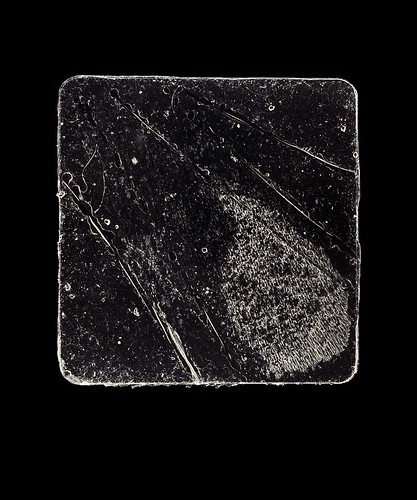
[Here’s what Lightner says she acquired for the collection this Fiscal Year, which ends at the end of this month. She added them up as we were talking, so the numbers may be a little rough.
8 artists books bought
35 artists books donated
6 photographs bought
22 prints commissioned
9 prints bought
2 print portfolios bought
2 print portfolios donatedThe commissioned work? Lightner asked Joseph Labolito to document the Youth Study Center, inside and out. Labolito, who works at Temple and made one of the prints included in Continuum, in the section of work collected by Looney, is now printing.]
L. How long have you been director?
K. Since January ’05. I worked in Rare Books for 16 years. [By the way, if you’re anxious to donate work to the Free Library, they can only accept prints and photos with a largest dimension of 36 inches; and they can’t handle bequests of archives because of lack of space.] There’s only two of us on staff. …I can’t start a new collection. I can continue whatever is already there.
L. Is it only Philadelphiana?
K. At one point, Mr. Looney, …he also made a point of getting international photographs and a real range. We don’t really have the money to buy an Annie Leibovitz, or even a Ray Metzker. But that’s what I would like to be able to do.
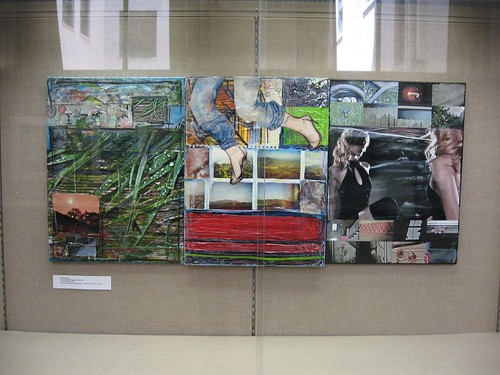
Jim Robinson, Experimental Photographic Work #2, detail, 3 part installation, 2007, hand colored digital pigment prints, C-prints and acrylic on canvas
L. Do people know about all this stuff that you have?
K. We got a number of art school classes this year that normally go the the museum [Philadelphia Museum of Art, but the prints and paper collection was closed because of the department moving to the new Perelman building]. Martha Madigan said she was just blown away, had no idea. [Here’s an online site for the photography and prints that date from 1839 to 1914.]
L. Do you do a lot of exhibits?
K. I do one big show down in the gallery, connected to whatever the theme of the Looney Memorial Event each year. [Continuum is this year’s]. This year’s panel included Katherine Ware from the Philadelphia Museum of Art [on 20s Avant Garde photography with some small Philadelphia focus], Steven Perloff from The Photo Review [on 60s and 70s Philadelphia], Martin McNamara from Gallery 339 [on the present] and Douglas Paschall from Woodmere [on historic photography in Philadelphia]. It’s a silent auction fundraiser for the department and a paid reception. Things get donated. The panelists helped. Between them they know everyone. Steven knows everyone. We got donations by Ray Metzger, Ann Hamilton–one of the pieces she did for Places in Time at the Print Center. That’s me [the blur in the pinhole picture Hamilton took in the library was Karen], George Krause.
This next year, we’ll do photography and printmaking together.
——————-
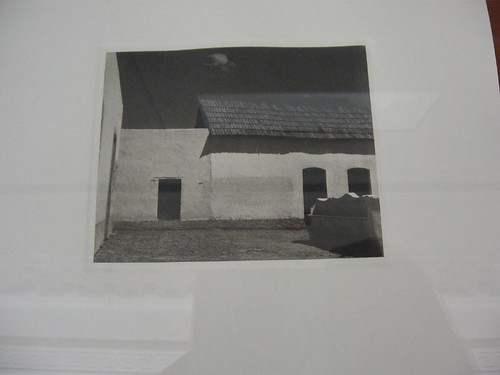
Paul Strand, Mexican Portfolio, 1933, photogravure
What I especially love about Karen’s being in this job is that for a change, a public institution that I think of as rather sleepy has managed to find the person with just the right qualifications for the job. By the way, there are almost always exhibits from Lightner’s department in the vitrines outside Prints and Pictures Department. Right now there are some Atgets, Paul Strands, etc. etc.
Continuum, which succeeds in showing how the era in which a photograph is made has a critical effect on what photography looks like, is up until July 6.



